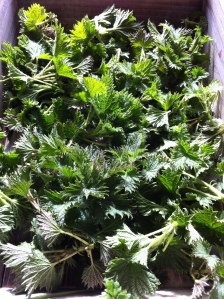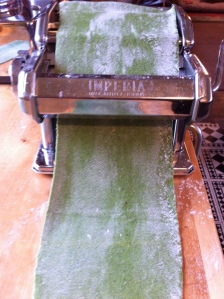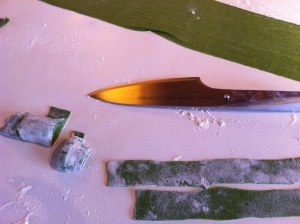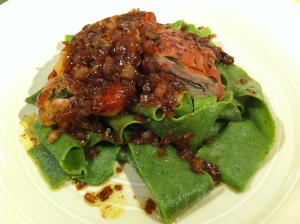With most of the vegetables in the garden yet to surface, it seems wholly appropriate to utilise our currently most successful garden edible, nettles, and combine these in a meal with some of our local Old Spot pork.
Nettles (Urtica dioica) really is a great plant species, and not just for eating. Don’t be put off by online diatribes about nettles being ‘unpalatable, disgusting or only survival food’, or statements such as ‘nettle recipes exist for the sake of eating an ingredient because you can’, etc, etc. The secret is in understanding when to pick them (young, early season tips only) and how to prepare them to really get the best from them.
Also, I don’t buy the argument that they are a hassle to prepare. They are most certainly less hassle to clean and prepare than some other veg we grow and prize e.g. globe artichokes. OK, an extreme example perhaps, but comparable with spinach, for sure.
Yes, nettles can be invasive in a garden, but if you have space for a patch they grow (too?) unabated, demand no attention and offer up a welcome lush green and nutritious crop during the hungry gap (our’s at least – it is longer than most). Later on, they are fabulous refuges and food for insects (and corncrake refuges here too), make superb nitrogen-rich liquid plant food and can help activate your compost heap. For all these reasons, I love my garden nettle patches. Of course, you don’t need to have them in the garden, there’s plenty to forage from urban wasteland, woods and meadows.
You might think that living where I do that a crop of pristine unpolluted nettles should be easy to forage. Well, it is true that we have significant nettle patches in the garden but nightly visits from deer, the dogs cheerfully marking their territory (including the nettles) and most recently, a wily sheep in occupation, make most of our nettles effectively unpalatable.
Even if I wanted to run the ‘urine gauntlet’, I’m reluctant to take an early crop of young nettle tops from our biggest patches. On occasional years, corncrakes arriving from their long migration take a welcome break in this early cover in our garden, especially if the irises have yet to get going, as is the case this year.
The rasping call of the males resonates for a few nights before they move on to more productive machair areas to establish breeding territories. I was optimistic that a corncrake may visit and benefit from our nettles as cover, but our very late i.e. non-existent spring means there was no cover to attract the first arrivals this year. They must have felt very exposed on arrival.
I shouldn’t exaggerate about our non-existent spring. It did occur on Sunday past after all, which was glorious and confusing all at the same time. I was fly fishing on Saturday wearing 3 layers of fleece, couldn’t feel my fingers and abandoned the outing. On Sunday, we were bewildered by the novelty of stunning sunshine, but not just that – warmth and managed t-shirts all day and a swim (for the dogs anyway, I’m not quite that hardy). Monday, same old, same old northerly wind, rain and low cloud. Where art though spring? Or please can we cut to the chase of summer?
Spring wildlife spectacular
Despite the less than ideal conditions, the wildlife is undeterred and the breeding season is in full swing. Lapwings and redshanks show their irritation as I pass by their breeding territories on my local run. I know exactly when and where to expect the next irate protective parent to rise from the vegetation to give me an earful as I pass by.
I watch the oystercatchers nesting round the bay having their frequent and noisy altercations with a pair of local ravens. Gregarious eiders also nest around the bay, the gentle and soothing call of displaying males resonates on (rare) still nights. Females will soon form crèches with their broods to help protect the vulnerable ducklings from predation.
The spring migration is ongoing and we currently have reasonable numbers of whimbrels on passage north, stopping at the bay at the bottom of the garden on their way to breeding grounds from Greenland across to Central Siberia. Male cuckoos make their presence heard and wheatears dart around the garden, a flash of white on the rump making them stand out against the grassy backdrop.
We have had spectacular views of a pair of hen harriers and short-eared owls hunting daily across the garden, often flying within a couple of metres of my office window. This is very distracting while I am working! Many parts of our garden have remained largely ungrazed for years and the sward is longer than the surrounding common grazing vegetation, so we have a genuine vole hotspot that is proving very fruitful for the local short-eared owls.
I have seen them hunt successfully on a number of occasions, once taking a short-tailed field vole literally from under the kitchen window. I never tire of watching their graceful billowing flight. One owl has regularly taken to saving energy by scanning the grass in the garden while perching on a favoured fence post.
Another rare and spectacular wildlife watching experience happened this week. For the first time since we have lived in this house, we had a visit from an otter in the bay at the bottom of the garden. It is not at all rare to spot otters here and we have had many very close encounters, but our bay is unlikely to form the core part of an otter territory due to the large component of the day when the tide is some distance out of the bay.
However, this young otter appeared to be exploring the area with a view to establishing a territory. It ran up and down the grassy slopes at the bottom of the garden, methodically exploring overhanging rocks some distance from the shore, before returning periodically to play and feed in the seaweed on the rising tide. It was delightful and a privilege to have such prolonged views of this secretive mammal from our window.
Nettles: weeding and feeding
My pristine young nettle tops were picked from my raspberry beds where no marauding beasts have access. This served to let the new rasp shoots have more space and light to grow. I find this to be the only downside to applying old manure (pig in our case) to permanent beds – weed seeds proliferate. The nettles are small beer though – I’ve got my hands full with the chickweed later in the season.
I have a pretty extreme reaction to nettle stings, so I harvest using heavy-duty rubber gloves – gardening gloves are not robust enough and I learned my lesson the hard way when I was stung through them.
Although sensitivity to stinging nettles does vary between individuals, my sensitivity has very much increased as I have got older. I remember, like most children, running through nettle patches and coming out with the familiar white blotches and associated red rash, but it never really hurt as much as just irritated slightly. I would just grab a dock leaf (Rumex spp.), rub it vigorously over the affected area, usually my knees, until my skin turned green from the dock and then continue on my merry way.
Now, even the slightest brush against the youngest stem covered in the small silky irritant hairs, which contain histamine, serotonin and formic acid among other things, is to be avoided. These hairs generate the familiar rash but this is coupled with considerable pain. Although the rash looks the same, the pain stays and I can feel the effects for up to 2 weeks after being stung and the area of skin remains tingly and sensitive, which is a bit disconcerting. I wonder how common increased sensitivity is with age and expect it isn’t unusual, just unpleasant!
Preparing your nettles
I wanted to incorporate the nettles into pasta. The best way to deal with them for this is to blanch the young tips, plunge them into boiling water for 3 – 4 minutes, then refresh in ice cold water to retain the vibrant colour. The stings are now gone and the nettles can be handled.
All stems should be removed and the leaves squeezed lightly before blitzing in a food processor to a fine texture. The nettles then need to be squeezed hard to remove as much moisture as possible as this will impact on the texture of the pasta.
Nettle pappardelle
I wanted to make a rustic hearty pasta to accompany the pork and thought pappardelle would be a fitting choice for the nettle and to complement the gutsy flavour of the pork scaloppine. I have used the same pasta recipe for about 20 years as it has never let me down. It is from Nick Nairn’s first book ‘Wild Harvest’. The standard recipe calls for 150g of flour (plain, but I use ’00’). For this recipe I used 180g to offset the additional moisture the nettle brings to the mix. I got away with it. Just.
Ingredients
180g flour, ’00’ or plain
1 whole egg, medium
1 egg yolk, medium
80g of fresh young nettle tips, rinsed, blanched and refreshed, trimmed and blitzed
Method
- Combine the flour, eggs, blitzed and squeezed nettles together in a food processor for 2 – 3 minutes. The mix should resemble fine breadcrumbs, not be gooey. Add a bit more flour if it is.
- Tip out the dough and knead briskly for 1 minute. Wrap in cling film and place in the fridge to rest for an hour.
- Cut the dough into 2 pieces, flatten each with a rolling pin to 5 mm thick then roll and refold the dough 7 times until you have rectangles about 8 x 18 cm. This is important to work the gluten to get a shiny dough and gives the correct al dente texture after cooking.
- Using a pasta machine, set the rollers at the widest setting, pass through the dough and repeat, reducing the roller setting with each pass until the penultimate setting. Pass through at this setting again and hang up to dry for at least 5 minutes.
- Lay the pasta sheet out on a lightly floured surface and roll before slicing about 2 cm wide to produce rustic pappardelle ribbons. Hang them up again until you are ready to use them.
- To cook, place in salted boiling water, bring back to the boil and cook for 2 – 3 minutes. Check the texture as you cook.
Pork scaloppine with prosciutto, capers and balsamic vinegar – a fitting accompaniment
Ever since I got a hold of our local Old Spot pork, one particular recipe has been pouting at me and I knew it would work very well with this nettle pasta. I saw this recipe on the The Garum Factory blog pages. The pork is sumptuously blanketed in prosciutto with pungent sage delicately folded within which also shines enticingly through the prosciutto. The sauce is perfect with the pork – and the nettle pappardelle.
Jody and Ken are not just accomplished chefs, but Ken is also a superb photographer. His images capture the essence of this recipe and my photos would simply not hold up to their exquisite gallery of images that accompany the recipe. I do not reproduce the recipe, but it can be found here. Thank you Jody and Ken. It was really delicious!

















































